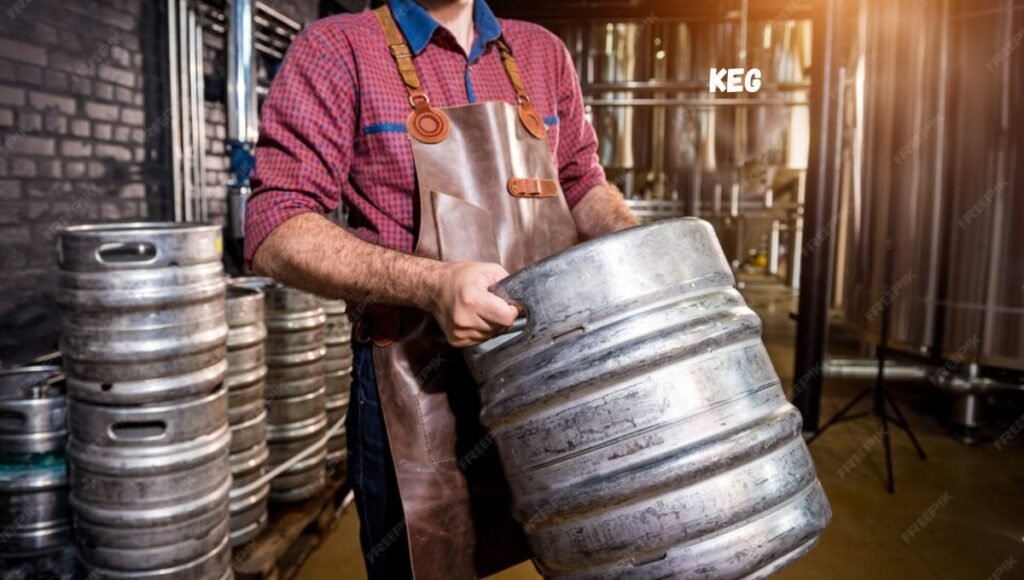A keg is a small barrel typically made of stainless steel, used to store, transport, and dispense beverages, most commonly beer. Kegs come in various sizes, ranging from the popular half-barrel (15.5 gallons) to smaller options like the quarter-barrel and sixth-barrel. Kegs are widely used at bars, restaurants, and homebrewing setups due to their ability to keep drinks fresh while allowing easy serving through tap systems.
The key advantage of using a keg is its ability to preserve the carbonation and freshness of beer or other beverages. Kegs also reduce waste, as they are reusable and more environmentally friendly than single-use bottles or cans.
Different Types of Kegs
Kegs come in various types, each suited to different needs:
- Half-Barrel Keg: The most common keg size, holding 15.5 gallons or approximately 165 12-ounce servings.
- Quarter-Barrel Keg: Also known as a “Pony Keg,” it holds 7.75 gallons, providing about 82 12-ounce servings.
- Sixth-Barrel Keg: This smaller option holds 5.16 gallons and yields around 55 12-ounce servings.
- Cornelius Keg (Corny Keg): Popular among homebrewers, the Corny keg holds 5 gallons of beer.
The size and type of keg you need depend on the event, the number of guests, and the type of beverage you plan to serve. For smaller gatherings, the sixth-barrel or Corny keg is a great choice, while larger events often call for a half-barrel.
Benefits of Using a Keg
Kegs offer several advantages for those who frequently serve beverages:
- Cost-Effective: Kegs reduce the cost per serving compared to purchasing individual cans or bottles, especially for large gatherings or events.
- Freshness: Kegs are designed to maintain the freshness of beverages by keeping them sealed and pressurized, which preserves carbonation.
- Eco-Friendly: Reusable kegs reduce packaging waste, making them an environmentally friendly option.
- Convenience: Keg systems, often paired with taps, allow for easy serving and eliminate the need to constantly open bottles or cans.
For parties or bars, kegs offer the convenience of bulk servings without compromising the taste or quality of the beverage.
How to Set Up a Keg System
Setting up a keg system requires the right equipment, including a CO2 tank, regulator, and tap or faucet system. Here’s a simple guide to setting up a keg:
- Chill the Keg: Keep the keg in a refrigerator or ice bucket for several hours before serving to ensure the beverage is properly chilled.
- Connect the CO2 Tank: Attach the CO2 tank to the keg using a regulator and line. The CO2 ensures proper pressure inside the keg, maintaining carbonation and allowing easy dispensing.
- Tap the Keg: Depending on the type of tap system, attach the tap to the top of the keg, ensuring a secure connection.
- Pour the Beverage: Open the tap and pour the drink into a glass, adjusting the pressure if necessary for a smooth flow.
Keg systems can be used in various settings, from home bars to large events. It’s essential to maintain the system regularly by cleaning the lines and taps to avoid contamination.
How to Store a Keg Properly
Proper storage of kegs is essential to maintain the freshness and quality of the beverage. Here are a few key tips for storing a keg:
- Keep it Cool: Store your keg in a refrigerator or at a consistent cool temperature (between 34-38°F) to prevent the beverage from spoiling.
- Store Upright: Always keep the keg in an upright position to maintain proper pressure and avoid leaks.
- Check the Expiration: Kegged beverages, especially beer, have a shelf life. Be sure to check the expiration date and consume the contents within the recommended timeframe.
Following these steps will ensure your kegged beverages stay fresh and delicious for as long as possible.
FAQs About Kegs
1. How many beers are in a keg?
A standard half-barrel keg holds 15.5 gallons of beer, which is equivalent to approximately 165 12-ounce servings. Smaller kegs, like a quarter-barrel, hold around 82 servings, while a sixth-barrel provides about 55 servings.
2. How long does beer last in a keg?
Once tapped, a keg can keep beer fresh for 30-60 days when stored in proper conditions (cool and pressurized). If the keg remains untapped and refrigerated, it can last up to 6 months.
3. Can I reuse a keg?
Yes, kegs are designed to be reusable. After each use, it’s essential to clean the keg and any associated equipment to maintain hygiene and prevent contamination. Many brewers offer keg return programs, allowing you to refill the keg rather than buying a new one.
4. What is the best way to clean a keg?
Cleaning a keg involves rinsing it with hot water, followed by scrubbing with a keg cleaner or sanitizer. Be sure to clean the tap lines and any associated equipment regularly to maintain the quality of the beverage.
5. Can you keg homemade beer?
Yes, homebrewers often use Cornelius (Corny) kegs for their homemade beer. Kegging beer allows for better carbonation control, fresher flavor, and easier serving than bottling.
Conclusion
Kegs offer an excellent solution for serving beverages in bulk, whether at home, at a bar, or during events. They provide a cost-effective, eco-friendly, and convenient way to store and serve beer, cider, or other carbonated drinks. By understanding the different types of kegs, how to set up a keg system, and proper storage techniques, you can enjoy fresh beverages for weeks. Whether you’re hosting a party or managing a bar, a keg can be your go-to solution for easy and efficient serving.


